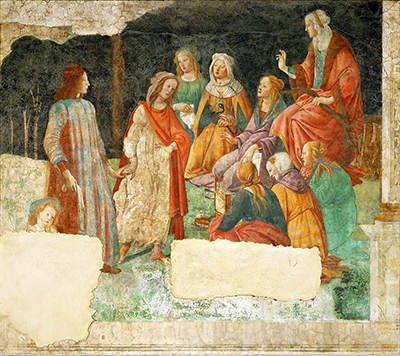This fresco was significantly damaged when first discovered in the Italian countryside but still retains some significant appeal within Botticelli's career
The original fresco has been cleaned, restored and mounted on canvas and is now stored at The Louvre (Musée du Louvre) in Paris, France.
This large fresco is sized at 237 cm × 269 cm, dated circa 1483-1486 and was originally accompanied by a sister artwork, Venus and the Three Graces Presenting Gifts to a Young Woman on the other side of a window. They were recovered as fragments at the same time, having been hidden under old whitewash for centuries.
The location of their recovery was the Villa Lemmi, by Careggi Hill. It was nearby to a villa owned by Cosimo de Medici which may give a clue as to how they ended up in this unfortunate situation.
Once sold on to The Louvre, they will have received the finest care and restorative techniques in order to maximise what is left of them both. The frescos also have great importance in that as secular works they are particularly rare within Botticelli's overall career.
The research that has been completed on them concludes that the most likely scenario is that they were a gift to commemorate the marriage of Lorenzo Tornabuoni and Giovanna degli Albizzi, who were connnected to both the Medici family and also the owner of the villa itself, the Tornabuoni family.
The title of the artwork refers to seven liberal arts and these are namely rhetoric, dialectics, arithmetic, grammar, geometry, astronomy and music. The fresco is also sometimes referred to as Lorenzo Tornabuoni Presented by Grammar to Prudentia.




